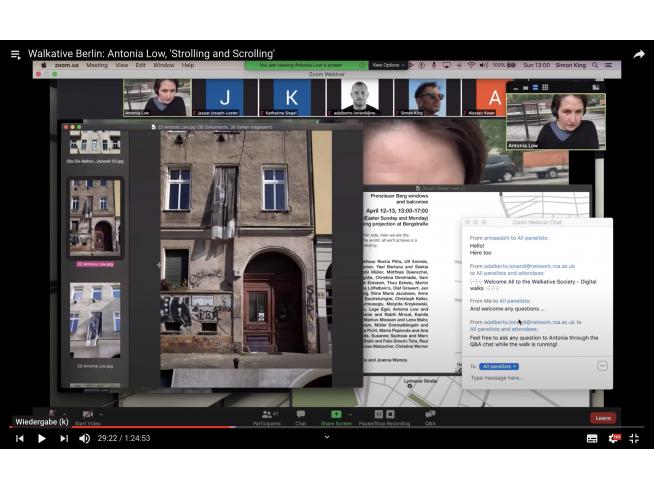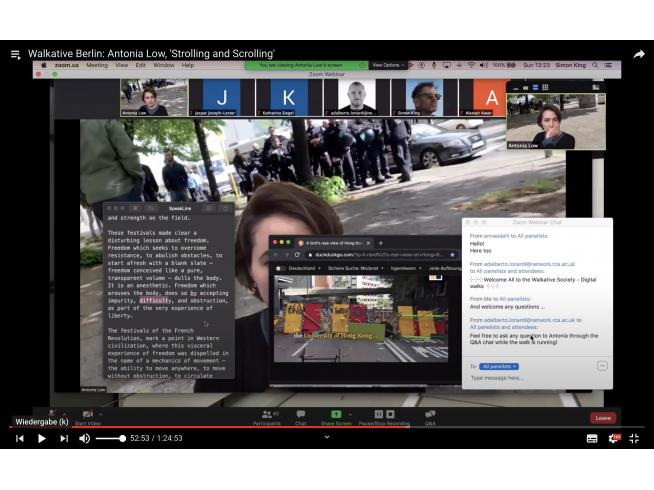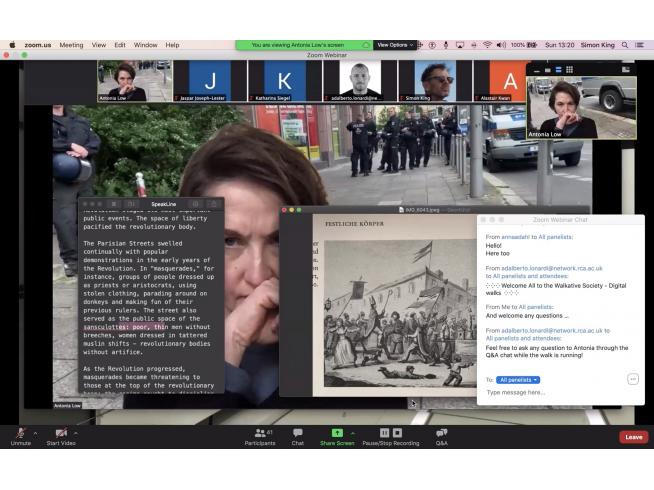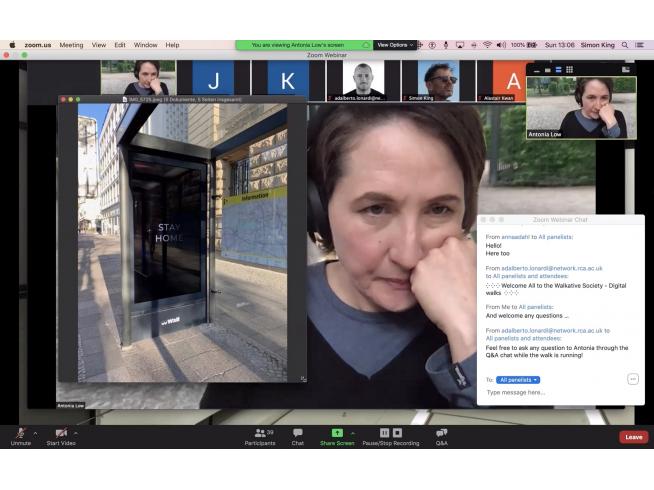Walking Cities in Lockdown
Walking Cities in Lockdown
An Interview with Antonia Low, artist in Berlin, by Jaspar Joseph-Lester and Simon King as part of their Walkative Project.
For the article "Walking Cities in Lockdown" published at Art & the Public Sphere Journal we invited participants to respond to a series of questions designed to draw out reflections on how the pandemic has forced us to consider urban walking in ways which extend into the digital sphere of online dialogue and screen sharing. As we moved from one global city to the next, we began to see how different approaches to the enforcing of restrictions embodied broader political, economic and cultural differences. Different lockdown measures impacted on the way we experienced the virtual walk and in each case led to deeper discussions about the heightened presence of ideological structures embedded within shared public space.
In their responses to these questions, Robin Kirsten (Cape Town), Hannes Brunner responding on behalf of collaborative colleagues Viviana and Mark Uriona and Meitaka Kendall-Lekka (Majuro, Marshall Islands), Antonia Low (Berlin) and Anna Ådahl (Stockholm), share a number of complementary themes. Key to this is the question of how we walk in the post-pandemic city and how that might include transgressive, atomized and collective thoughts, affects and experiences. See the online presentations here.
Jaspar Joseph-Lester and Simon King: How do we walk in a post-pandemic city?
Antonia Low: Walking in Berlin, I am cautious about my body’s presence in public, my pace, my breath. With this awareness, I try to keep a safe distance from elderly, fragile-looking people. I try to keep a safe distance from sweating joggers and large groups in the parks. I imagine clouds of sweat and saliva drops surrounding such hyperactive individuals as aerosols unfold from their bodies and unmasked mouths. This makes me want to step far away from all and walk in pure solitude. The smell and feel of clean, fresh air has become a tangible pleasure.
JJ-L and SK: How does this change in the way we navigate and negotiate the urban help us to rethink cities?
AL: Public transport I avoid, even though I know that the system in Berlin is safe, efficient and better for the environment. However, I have started getting claustrophobic-like feelings in trams or on cramped buses. I feel I am trapped in an enclosed capsule with no air and only infectious aerosols for me to breathe. At the same time, it is a growing worry to stand next to a person who might refuse to wear a mask and who possibly wants to start an argument about it. Wearing a mask has become a statement about attitudes and beliefs. On some weekends, I purposely put on a mask to distinguish myself from demonstrating groups that gather on the streets of Berlin. A growing number of people from different backgrounds and beliefs regularly come to the city from across Germany to demonstrate against the rules and guidelines resulting from the pandemic, against vaccination and against Angela Merkel’s supposed dictatorship (“Corona-Diktatur”) – all along with alt-right, anti-democratic ‘Reichsbürger’. Public places in Berlin have turned into sites for negotiation of all attitudes and beliefs triggered and generated online on social media.
JJ-L and SK: What have we learned from walking cities online?
AL: First of all, it is very inspiring to explore all kinds of new methods to connect with one another. Being on a virtual walk, I am led through a gaze and pace of another viewer. I try to associate to what is presented on my screen and the adjoining monologue. It is seductive, pacifying, I generally appreciate passively getting a subjective insight to a site. However, what I have learned from walking cities online is that I lack the real, subtle, tangible experiences of the individual site: the smell of the air, the light, the cacophony of sounds in the streets and distracting urban details – such as street signs, pavement, lamp posts, walls, fences. I miss the possibility of wandering off, away from the group, with my own reflections.
JJ-L and SK: How does this group activity allow us to consider practice differently?
AL: My own walk was an experiment. A sort of ‘lecture-performance’, in which I was tempted to try out all the possibilities for communicating via the video-conference app Zoom. However, performing as a virtual walker, I felt seasick. It started with a shared desktop on which two filmed tours through Berlin were presented as a virtual background and on top of which another layer of moving images, documentation of an exhibition and texts, were superimposed. The text was read out by ‘Tessa’, a female computer voice on Speak Line. During the Q&A, comments popped up as an extra layer for me to read. It gave me a splitting headache having to focus on the tiny moving letters, trying to comprehend the content and make sense with my answers. The actual communication turned into a growing physical pain as I felt increasingly nauseous. After the meeting, I had to lie down for an hour or two. After this, I called you up, Jaspar, and found out that both of you had had the same experience. To potentially make an entire online group feel nauseous from a virtual walk experiment was an unexpected outcome. Even though we might feel isolated in front of the screen, listening to monologues, there is something else to be sensed, and that is a group practice and experience. We should listen and observe intensely to what we have been experiencing together, it’s something beyond an informative monologue.
JJ-L and SK: If urban walking impacts on the way we think, research and make, how has lockdown led to new ways of working as artists?
AL: Close artist friends have become very dear to me. I was longing to reconnect with them so I invited a few friends in September, to meet in person and to go on a half-day walk together through Berlin Lichtenberg, as a type of collaboration. We exchanged our personal experience of the past months while also reflecting on the redefinition of closeness and exchange as we walked down shabby streets and through small urban gardens. Pointing out details, referring to something else, seeing through each other’s eyes, our dialogue emerged through sharing the experience of walking together. These very natural and old methods of being together, now seem so refreshing. In the end, these Berlin walks resulted in a series of collaborative works: drawings of gravestones for one another, a classified ad on eBay, a photo-collage, texts or simply the understanding to meet again.
JJ-L and SK: What potential does online urban walking have for collaboration and dialogue with other practitioners?
AL: Online urban walking is not about sharing each other’s company. Instead, a virtual walk gives me a very good insight into other ways of seeing. The possibility of exchanging perspectives, zooming in and out and contextualizing a site is informative and compelling. Such artistic strategies help appreciate under-represented views, help overcome western-informed traditions and open the canon for comprehending the world’s complexity. A spectrum of views constructs our world with assumptions and attitudes coexisting and informing us humans, where we are and what we are. However, we all experience the walks individually. My own senses are essential for my inspiration and for making art. Or is this also an obsolete human centred tradition in art practice that has to be challenged?
Jaspar Joseph-Lester is an artist, reader in Art & Post-Urbanism and Head of the MA Sculpture Programme at the Royal College of Art in London. He co-founded the Walkative Project in 2013, which explores how walking can trigger processes of thinking, researching, collaborating and making.
Simon King is a co-founder of the Walkative project, a tutor at the Royal College of Art and currently undertaking a walking arts practice-led Ph.D. at Birkbeck, University of London.
Antonia Low was invited as an artist to the Walkative project during the first Lockdown in April 2020. The central subject in her art practice is the interaction with architectures and the relation to their materiality, aesthetics and history. She is professor for the new programm Körperraumnarration at the Staatliche Akademie der Bildenden Künste Stuttgart.






